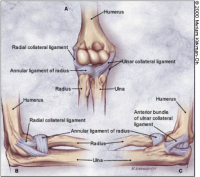Elbow Varus Stress: Difference between revisions
No edit summary |
Kai A. Sigel (talk | contribs) (Deleted two older videos with bad audiovisual quality and replaced it with an improved version.) |
||
| Line 14: | Line 14: | ||
With the patient standing, the therapist places the patient's elbow in slight flexion while palpating the humeroulnar joint line. The therapist then applies a varus force to the elbow. This test is considered positive if the patient experiences pain or excessive laxity is noted compared to the contralateral side.<ref>Flynn, T.W., Cleland, J.A., Whitman, J.M. (2008). User's guide to the musculoskeletal examination: Fundamentals for the evidence-based clinician. Buckner, Kentucky: Evidence in Motion</ref> The test can be repeated in varying degrees of elbow flexion, but generally it is positioned between 5 and 30 degrees.<ref>Dutton, M. (2008). Orthopaedic: Examination, evaluation, and intervention (2nd ed.). New York: The McGraw-Hill Companies, Inc.</ref><br><br> | With the patient standing, the therapist places the patient's elbow in slight flexion while palpating the humeroulnar joint line. The therapist then applies a varus force to the elbow. This test is considered positive if the patient experiences pain or excessive laxity is noted compared to the contralateral side.<ref>Flynn, T.W., Cleland, J.A., Whitman, J.M. (2008). User's guide to the musculoskeletal examination: Fundamentals for the evidence-based clinician. Buckner, Kentucky: Evidence in Motion</ref> The test can be repeated in varying degrees of elbow flexion, but generally it is positioned between 5 and 30 degrees.<ref>Dutton, M. (2008). Orthopaedic: Examination, evaluation, and intervention (2nd ed.). New York: The McGraw-Hill Companies, Inc.</ref><br><br> | ||
{{#ev:youtube|5zl8GsG3hR4}}<ref>Physiotutors. Elbow Varus Instability Stress Test⎟Lateral Collateral Ligament. Available from: https://www.youtube.com/watch?v=5zl8GsG3hR4</ref> | |||
== Evidence == | == Evidence == | ||
Revision as of 20:44, 20 February 2017
Original Editor - Tyler Shultz
Lead Editors
Purpose
[edit | edit source]
The purpose of the varus stress test of the elbow is to assess the integrity of lateral collateral ligament.
Technique
[edit | edit source]
With the patient standing, the therapist places the patient's elbow in slight flexion while palpating the humeroulnar joint line. The therapist then applies a varus force to the elbow. This test is considered positive if the patient experiences pain or excessive laxity is noted compared to the contralateral side.[1] The test can be repeated in varying degrees of elbow flexion, but generally it is positioned between 5 and 30 degrees.[2]
Evidence[edit | edit source]
Provide the evidence for this technique here
Recent Related Research (from Pubmed)[edit | edit source]
Failed to load RSS feed from http://eutils.ncbi.nlm.nih.gov/entrez/eutils/erss.cgi?rss_guid=1B_L1tLIz1OHHZs6CFKkLA4UzUdDfs_WFvy2bF4giDrBu2dQ2|charset=UTF-8|short|max=10: Error parsing XML for RSS
References
[edit | edit source]
- ↑ Flynn, T.W., Cleland, J.A., Whitman, J.M. (2008). User's guide to the musculoskeletal examination: Fundamentals for the evidence-based clinician. Buckner, Kentucky: Evidence in Motion
- ↑ Dutton, M. (2008). Orthopaedic: Examination, evaluation, and intervention (2nd ed.). New York: The McGraw-Hill Companies, Inc.
- ↑ Physiotutors. Elbow Varus Instability Stress Test⎟Lateral Collateral Ligament. Available from: https://www.youtube.com/watch?v=5zl8GsG3hR4







